
Triton is a Greek god of the sea, the son of Poseidon and Amphitrite, god and goddess of the sea respectively. Triton lived with his parents in a golden palace on the bottom of the sea. Later he is often depicted as having a conch shell he would blow like a trumpet.

A shofar is an ancient musical horn typically made of a ram's horn, used for Jewish religious purposes. Like the modern bugle, the shofar lacks pitch-altering devices, with all pitch control done by varying the player's embouchure. The shofar is blown in synagogue services on Rosh Hashanah and at the end of Yom Kippur; it is also blown every weekday morning in the month of Elul running up to Rosh Hashanah. Shofars come in a variety of sizes and shapes, depending on the choice of animal and level of finish.

Conch is a common name of a number of different medium-to-large-sized sea snails. Conch shells typically have a high spire and a noticeable siphonal canal.

Stephen Johnson Turre is an American jazz trombonist and a pioneer of using seashells as instruments, a composer, arranger, and educator at the collegiate-conservatory level. For sixty years, Turre has been active in jazz, rock, and Latin jazz – in live venues, recording studios, television, and cinema production.

Aliger gigas, originally known as Strombus gigas or more recently as Lobatus gigas, commonly known as the queen conch, is a species of large sea snail, a marine gastropod mollusc in the family of true conches, the Strombidae. This species is one of the largest molluscs native to the Caribbean Sea, and tropical northwestern Atlantic, from Bermuda to Brazil, reaching up to 35.2 centimetres (13.9 in) in shell length. A. gigas is closely related to the goliath conch, Lobatus goliath, a species endemic to Brazil, as well as the rooster conch, Aliger gallus.

Charonia is a genus of very large sea snail, commonly known as Triton's trumpet or Triton snail. They are marine gastropod mollusks in the monotypic family Charoniidae.
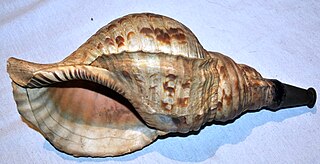
Horagai are large conch shells, usually from Charonia tritonis, that have been used as trumpets in Japan for many centuries. The instrument, which has served a number of purposes throughout Japanese history, has been given a number of Japanese names depending on its function. Special schools still teach students to play the traditional music associated with the conch.

The operculum is a corneous or calcareous anatomical structure like a trapdoor that exists in many groups of sea snails and freshwater snails, and also in a few groups of land snails; the structure is found in some marine and freshwater gastropods, and in a minority of terrestrial gastropods, including the families Helicinidae, Cyclophoridae, Aciculidae, Maizaniidae, Pomatiidae, etc.
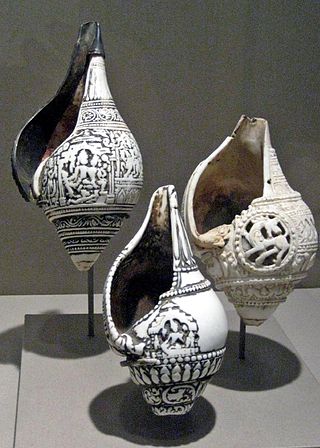
A shankha has religious ritual importance in Hinduism.
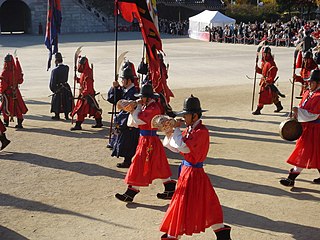
The nagak is a wind-instrument made from a large seashell and played as a horn in Korean traditional music. It produces only a single tone and is used primarily in the military procession music called daechwita. The mouthpiece of the nagak is made by making a hole in the pointed end of the conch, into which a mouthpiece is fitted. This instrument is first recorded as being used in Goryeo.
The chromatic trumpet of Western tradition is a fairly recent invention, but primitive trumpets of one form or another have been in existence for millennia; some of the predecessors of the modern instrument are now known to date back to the Neolithic era. The earliest of these primordial trumpets were adapted from animal horns and sea shells, and were common throughout Europe, Africa, India and, to a lesser extent, the Middle East. Primitive trumpets eventually found their way to most parts of the globe, though even today indigenous varieties are quite rare in the Americas, the Far East and South-East Asia. Some species of primitive trumpets can still be found in remote places, where they have remained largely untouched by the passage of time.
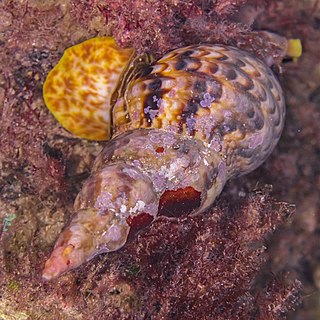
Charonia tritonis, common name the Triton's trumpet, the giant triton or pū is a species of very large sea snail, a marine gastropod mollusc in the family Charoniidae, the tritons. Reaching up to two feet in shell length this is one of the biggest mollusks in the coral reef.

The blowing horn or winding horn is a sound device that is usually made of or shaped like an animal horn, arranged to blow from a hole in the pointed end of it. This rudimentary device had a variety of functions in many cultures, in most cases reducing its scope to exhibiting, celebratory or group identification purposes. On the other hand, it has kept its function and profile in many cattle raising, agricultural and hunter-gatherer societies.

The pūtātara is a type of trumpet used by the Māori people of New Zealand. It is customarily made with a carved wooden mouthpiece and a bell made from New Zealand's small native conch shells or triton shell. Larger pūtātara were particularly prized as the triton shell was rarely found and only sometimes washed up on the beaches in the Far North. It is often blown in guest welcoming ceremonies.

Charonia lampas is a species of predatory sea snail, a marine gastropod mollusk in the family Charoniidae.

Charonia variegata, the Atlantic triton or Atlantic triton's trumpet, is a species of predatory sea snail, a marine gastropod mollusk in the family Charoniidae, the triton snails, triton shells, or tritons.
The hakgediya is a type of conch shell which is used as a kind of trumpet in the traditional ritualistic music and religious folk art-music of Sri Lanka, which has been somewhat influenced by Indian music. The hakgediya is an aerophone, or Susira. This instrument was used mainly in Theravada Buddhist artistic rituals which also involved other categories of instruments such as Ghana, Avanaddha, and Tat.

Titanostrombus galeatus, commonly known as the Eastern Pacific giant conch, is a species of large sea snail, a marine gastropod mollusk in the family Strombidae, the true conchs and their allies.

Xochipilli, subtitled "An Imagined Aztec Music", is a short composition for four wind instruments and six percussionists by the Mexican composer Carlos Chávez, written in 1940. Its original title was Xochipilli-Macuilxóchitl, which is the double name of an Aztec god in two of his aspects, meaning "Flower Prince" and "Five Flower".


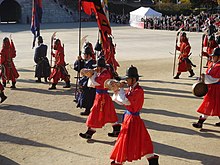


![Aztec conch shell trumpeter called quiquizoani [kiki'soani]
. (mid-16th century) Codex Magliabecchi Aztec conch shell trumpeter quiquizoani.png](http://upload.wikimedia.org/wikipedia/commons/a/a9/Codex_Magliabecchi_Aztec_conch_shell_trumpeter_quiquizoani.png)




















